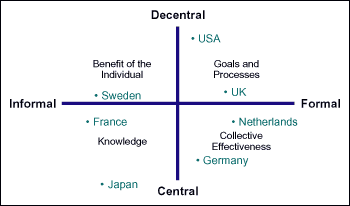
At its best, Six Sigma is about organizational improvement. Six Sigma focuses on process improvement, design and management. But, it is as much about people’s behavior as it is about the behavior of processes. After all, how can one separate the behavior of processes from the behavior of people? That must remain a central thought for those implementing Six Sigma across Europe.
National Cultures and the Route to Change
The way organizations change is influenced by their predominant national culture. Since Six Sigma is about organizational change, it has implications for how companies ascribe status, recognize performance, structure reporting lines and communicate. Reporting lines, to pick an example, have different meanings depending on whether one is located in Staines or Stuttgart. That is because the whole notion of an organization and the purpose it serves is influenced by national culture.
Management consultant and author Fons Trompenaars (Riding the Waves of Culture – Understanding Cultural Diversity in Business, Nicholas Brealey Publishing Limited, 1993) sees four primary organizational archetypes depending on the degree to which organizations are decentralized or centralized, informal or formal. His research shows that the United States and the United Kingdom are relatively decentralized and formal in their approach to organizations. Their purpose, like guided missiles, is to achieve defined targets. In that context, talking about goals and processes comes naturally. Add to that the fact that the United States celebrates the achievement of individuals, and the result is a very receptive environment for Six Sigma – an approach to improving process performance based on competent individuals driving results.
Different Techniques for Success
In The Netherlands or Germany, where organizations are more centralized, collective effectiveness is the objective of organizational improvement. There, raising the capabilities of a work team, department or business unit is the focus. Singling out individuals for recognition via special training or certification risks creating an elite group who will be resented by their peers. Rather, the power of Six Sigma is in improving everyone’s effectiveness by creating a culture of process discipline.

In southern Europe, business organizations are like families. Power for the good of the group is ascribed by virtue of knowledge. For senior managers to lead change in that context, they have to internalize, then personalize, the change for themselves and those for whom they feel responsible. In France, it means spending plenty of time educating senior managers about the leadership aspects of Six Sigma before ever picking process-based projects.
To a Swede, an organization is a vehicle through which the individual expresses him- or herself and can realize his/her full potential. It is an incubator. To generate enthusiasm for Six Sigma, one must anticipate the question, “How will Six Sigma help me be more creative?” The answer is, “When half of today’s problems are avoided through better processes, you will have more time to be creative!” Six Sigma frees up the capacity of individuals to grow and learn. Its success depends on it.
Six Sigma Starting Points and Approach
Depending on the geographic region in Europe, one must change the starting point and approach to implementing Six Sigma.
Generating genuine enthusiasm for Six Sigma means putting it in the right organizational context and communicating accordingly. Cultural differences call for these different approaches:
- In a French company, build awareness among senior managers and all employees before rolling out Black Belt or Green Belt training. Develop measures and actions to improve employee satisfaction.
- In a German company, clearly define who is responsible for Six Sigma and how it fits with other initiatives. Use Six Sigma as a means to elevate collective performance through the wider application of advanced process methods.
- In a British company, link Black Belt and Green Belt appointments to career development for high-potential managers. Use Six Sigma to communicate good ideas upward and provide recognition.
Summary: Universal Applicability, Individual Implementation
Six Sigma is universally applicable, though how one communicates the purpose of it and implements it should differ depending on the predominant national culture. Companies operating in Europe should beware of implementation approaches that are based on a U.S.-style emphasis on the capability of talented, well-trained individuals to get results “no matter what it takes.” CEOs should develop an explicit leadership strategy to introduce Six Sigma as a vehicle for strategic organizational change.
Years of experience have shown that the major implementation challenges are people-related. Therefore, it is important to bear in mind these pointers:
- Take stock early on of who is involved and how to motivate them to change.
- Be sure to incorporate “soft skills training” (e.g., facilitation and change management) in the Six Sigma curriculum.
- Train teams as well as individuals to build the capability of groups and their commitment to implement and sustain improvements.
- Be aware that teams from different countries will progress at different rates.